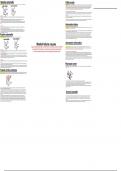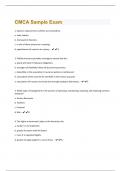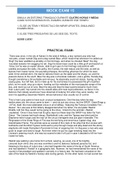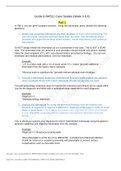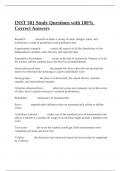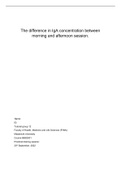Negative externality - adverse cost to a 3rd party e.g. local residents inhaling toxic smoke of chemicals increasing cancer
Public goods - have 2 key characteristics they are non-excludable and non-rival. They are non-excludable as no price can be
negextin Production neg eatin consumption charged to exclude consumers from purchasing the good, as the benefits of consuming the good cannot benefits confined
PtctB solely to individuals who have paid for it, there also may be no cost effective way to charge consumers and exclude them
MSC mpc from using it. Non-rival as consumption of the public good, the supply available to others remains exactly the same
C MPC A
E.g. roads, beaches, flood defences, road signs, street lights and firework displays
B i B '
' A '
'
l I 1
IC MPB P: public goods leads to the free rider problem
/ ! MPB I ! MSB C: where rational consumers have an incentive not to pay for public goods and instead wait and free ride on the payments of
others. If everyone acts rationally no one will pay for public goods. No profit motive for private firms in the free market to
S f
S F Q o m supply them
production o
o
o
m o o
C: no supply in the free market despite a huge social demand (roads). This leads to complete market failure and a missing
P: In a free market individual producers only consider their private costs of production and ignore all social costs of market and allocative inefficiency
their actions
C: resources are allocated at the private equilibrium FMO so there is an over production and over consumption. Eval However due to technology changes it is becoming easier to exclude consumers from the consumption of public goods
Pricing is also too low, incentivising mode consumption thus production, worsening the problem e.g. electric road pricing (road tolls) and music and video services with encryption with file sharing
C: end result is a misallocation of resources, allocative inefficiency where too many resources are allocated then what
is socially desirable. Generating welfare loss of ABC with society bearing more costs than benefits with units beyond
SOO
Consumption
Information failure
P: in a free market individual consumers only consider private benefits in consumption and ignore the the full social Information failure - is where individuals/firms have a lack of information about an economic decision e.g. are consumers aware
benefits of their actions due to self interest of the health costs of consuming full fat yogurt
C: resources are allocated at the private equilibrium of FMO, this is an over production and over consumption
C: results in misallocation of resources, allocative inefficiency, where too many resources are allocated to this market P: free markets assume that information is perfect thus consumers, producers and government will make rational decisions that
than what is socially desirable. This generates a welfare loss with society bearing more cost than benefit given the maximise their benefit, but in reality this isn’t the case
units beyond SOO being produced C: if there is information failure, decisions will be made in ignorance or imperfect information. when consumers lack perfect
Positive externality knowledge of just how good or bad consuming a product that isn’t very good for them a s when packaging misleads or
purposefully promotes incorrect information to convince consumers to buy products that are not in their best interest
C: end result is consumers making irrational decisions, either under or over consuming where their total benefit is not being
Positive externality - benefits to a 3rd party e.g. eating healthy food will increase productivity at work maximised. There are therefore either too few or too many resources being allocated to such markets causing a misallocation
posextin Production
Posextin consumption of resources, allocative inefficiency and market failure
mpc
mpc
Asymmetric information
C
in ↑
Market failure causes
a Msc
'
B
I I
1
MSB
4 I 1 I
1
'
I
'
MPB ! !
f S
MPB
Types; negative externality in production/consumption, positive externality Asymmetric information - occurs when information exists but is not equally shared between two parties resulting in the
consumer/producer lacking the information to make a rational, welfare maximising decision e.g. when purchasing a second
in production/consumption, merit good, de-merit good, public goods,
f g M
M 0
O
O
hand car, the buyer will not have the full information about the car unlike the seller
Production O O o
P: in a free market individual producers only consider their private costs of production and ignore the full social cost of their
action due to self interest common access resources, income inequality, monopoly power P: lnformation is not equally shared between parties
C: if consumers looking to buy second hand they do not have the full information over the products quality, information is
C: as a result resources are allocated at the private equilibrium of FMO. There is under production and under consumption in the
possessed purely by the seller. An irrational decisions to buy might be made as a result. Another example is an mechanic as
market as FMO is less than SOO
they can force extra payments to be made for repairs, which are perhaps not necessary. Consumers make irrational decisions
C: end result is misallocation of resources, allocative inefficiency where too few resources are allocated to this market than is
in accepting these repairs, which are perhaps not necessary and lack the information to know if they are
socially desirable. This generates a welfare loss with society losing out on units that are not being produced beyond FMO up to
C: end result is consumers making irrational decisions, either under or over consuming where their total benefit is maximised.
the SOO that would generate more benefit to society than costs
Therefore there are either too few or too many resources being allocated to such markets causing a misallocation of resources,
allocative inefficiency and market failure
Consumption
P: in a free market consumers only consider their private benefit and may ignore the full social benefit of their actions due to self
interest
C: as a result resources are allocated at the private equilibrium of FMO instead of the SOO. There is under consumption and
under production in the market as FMO is less than SOO
C: end result is a misallocation of resources, allocative inefficiency where too few resources are allocated go the market than is
Monopoly power
socially desirable. This generates a welfare loss with society losing out on units that are not produced beyond FMO up to SOO Monopoly - when there is a single seller in the market e.g. Thames water, or when a firm has a greater market share than
that would generate more benefit to society than cost 25% e.g. tescos
Tragedy of the commons MC
Tragedy of commons - common access resources are goods with no private ownership, as a result profit motivated producers AC
pm
follow their self interest (profit max) will exploit the resource, eventually resulting in their depletion/degradation e.g. rivers & sea - - - - -
y DWL
Pc
:
%% mscext '
neg ! ar
MPC
B↓fg✓_ Qm Q'
MR
H I
P: A monopoly has a high market share (>25%), generally monopolies are profit maximisers
1 1
MPB C: This enables them to be able to exploit consumers by charging very high prices leading to a deadweight loss for society
1 I in both consumer and producer surplus. As monopolies operate at MC=MR at a output of QM and a price of QC, this is
s f extremely higher than the competitive outcome price of PC and a reduce quantity than QC
o m
o 0 C: the quantity is bellow the SOO at QM and not QC causing an misallocation of resources, allocatively inefficiency and a
welfare loss to society
P:in a free market individual producers only consider their private costs of production and ignore the social cost of their
actions (neg ext to 3rd party)due to self interest
C; self interest is profit max, where it is the best interest of producers to deplete the resource. There is no incentive to stop
extracting as other producers will confuse resulting in tragedy of commons regardless. Resources are allocated at FMO
instead of SOO. There is overproduction and overconsumption in the market as FMO is greater than SOO. The price is also
too low not reflecting the full social cost of production, incentivising consumption and thus more production, worsening the
Income inequality
problem
C: third parties are future generations that lose out from the over production from this over production and eventual P: In a free market it can lead to too many wasted resources for the rich and too few necessary resources for the poor
resource depletion as the major source of income has been closed. Furthermore they will not have the same access to C: due to price exclusion preventing the poor from being able to access necessity items such as food, shelter and
goods developed from such resources in the future reducing their material living standards. Current generations can loose healthcare, whereas the rich are able to afford expensive luxuries, such as multiple cars, holiday homes and designer
out from lost income and unemployment. Leads to misallocation of resources, allocative inefficiency where too many clothes
resources are allocated to this market than is socially desirable. This generates welfare loss with society bearing more cost C: resulting in an over consumption of goods and services by the rich and an underconsumption of goods and services by
than benefit with units beyond SOO being produced the poor, resulting in an misallocation of resources, allocative inefficiency and marketer failure

